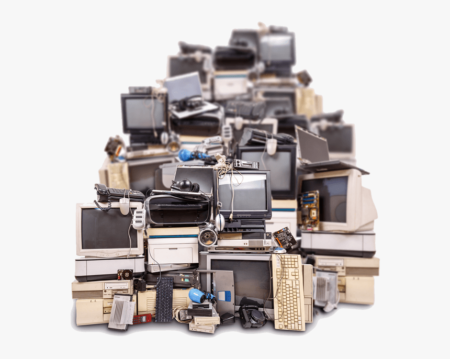March 28, 2020 – The blog post that follows represents Jenna Tsui’s third contribution to 21st Century Tech Blog. Jenna is editor and co-owner of The Byte Beat, a blog focused on technology. In this contribution, she tackles the growing problem of e-waste.
So what is it? If you are anything like me you may have accumulated quite a trove of digital devices that have outlived their use.
When I got Jenna’s article I took a look around in our home to take an e-waste inventory and discovered my wife has almost every cell phone she ever acquired from clamshells to smartphones. I, too, have some lying unused in my desk drawers. In our basement storage locker in the apartment building, we have a router, a range extender, a working micro-laptop, an electronic writing to digital text tablet, and an old but still serviceable audiovisual projector. All of these items take up space and fill a large sealed tub. I don’t need them but don’t know what to do with them. I know there are e-waste depots here in Toronto but all these devices still work. I just don’t have a use for them anymore now that we have downsized and I have retired from consulting.
Feeling like a packrat with all these devices made me wonder how others are handling their obsolete or discarded digital technology. I went online to find out just how much is out there. The World Counts website states “we generate about 50 million tons of it every year. This is equivalent to throwing out 1000 laptops every single second.” That’s an astounding amount. So with no further ado, I give you Jenna’s look at e-waste and what we can do about it.

Recycling is a major factor in the push for sustainability and green living. In recent years, you may have heard the term e-waste in discussions about recycling. If you’re not sure what it means, you’re not alone. E-waste is simply electronic waste. It can include anything from cell phones to laptops to refrigerators and more. Anything with an electrical aspect to it can become e-waste.
The problem lies with its handling. Recycling e-waste comes with a whole set of issues but there are ways to combat this environmental threat.
The Issues of E-Waste
E-waste affects the environment in numerous ways from the presence of toxic materials and pollutants within it to its transportation.
Dealing with Toxic E-waste Chemicals
Producing electronics relies on the mining of materials such as gold, silver, platinum, lithium and more. In extracting these raw materials there are process byproducts including toxic chemicals and heavy metals. Lead and mercury are among these.
The housings of electronic devices are often manufactured using polyvinyl chloride (PVC) plastic which in itself can prove to be hazardous in disposal.
Most electronic e-waste ends up in landfill where it breaks apart over time exposing the toxic materials inside to pollute the air, ground and water supply. This type of pollution produces many different health risks for people let alone harm to the environment.
Some e-waste gets incinerated which can also be a source of airborne toxins and emissions.
And some is recycled to prevent some of these risks. But even in recycling, there are problems because most of these operations take place overseas.
Exporting the E-waste Problem
Many countries in the Developed World export their e-waste to the Developing World. The practice has environmental consequences releasing greenhouse gas emissions during transportation and if recycled can release toxins into the environment. Workers in some Developing World countries often attempt to refurbish and sell salvageable e-waste but in the process they are exposed to dangerous chemicals and substances during the sorting process.
Then there is the issue of e-waste containing digital content that has not been removed by former owners potentially creating security issues and identity theft.
Recognizing the Consumer Demand Problem
You can no longer separate technology from your life, which is not necessarily a bad thing. The e-waste that is a byproduct of our technology dependence, however, is something that human society has to consider as we continue to be lured into buying a growing number of new devices. It seems that one can never keep up with the latest smartphone model with all of its bells and whistles making the device you already own seem obsolete when in fact it isn’t.
Manufacturers feed the demand by shortening the life cycle of their products. It often becomes easier to replace a device rather than repair it, and manufacturers making fixes more expensive than buying something new.
What Are the Solutions?
Raising awareness is an important first step. Consumers have a say and can let manufacturers know that e-waste is a problem for which they need to participate in finding solutions. That means improving production methods, replacing harmful materials in manufacturing with eco-friendly ones. And it means recycling e-waste has to be built into the product lifecycle.
Standard recycling is a beneficial way to help the environment. E-waste recycling is no different with those who do it implementing safety precautions and the wearing of protective gear during disassembly, cleaning, and sorting for material recovery. This type of recycling needs to be adopted globally to be effective and brings us to the issue of product lifecycle management.
The Circular Economy
The concept known as the circular economy is built around an industrial model involving not just material sourcing, manufacturing, and distribution, but also in the managing of a product after it is no longer being used. It is a solution that has become a growing practice for waste management and the electronics industry. In a circular economy, 100% of the materials going into a product get reused reducing waste and pollution significantly.
Today, there is a disproportionate gap between what society produces and what it discards and e-waste is no exception. This, however, is changing as more manufacturers and waste management companies adopt circular economy principles within their operations. The mantra is repair, reuse, remanufactured and refurbish with non-recyclable and single-use materials being removed from production processes.
How Consumers Can Help
- Limit the number of electronic devices you buy. You can do this by purchasing devices with more functionality rather than single-purpose electronics.
- Support eco-friendly technology companies by buying only from them.
- Opt for reused and refurbished devices over new ones. Doing this diverts usable equipment from becoming e-waste and you may even save some money.
- Look for environmentally friendly electronics with Energy Star or Electronic Product Environmental Assessment Tool (EPEAT) labels.
- Find the best way to recycle old electronics. You can look into local recycling programs and see how they process e-waste.
The growing demand for new technology is not going to slow down. So the future of e-waste will require a revolutionary change. A move by manufacturers to a circular economy offers a sustainable model for recycling and reuse. And finally, each of us individually, by changing what and when we buy, can save the environment from piling up an increasing amount of e-waste.















